A beginner’s guide to Extremadura
Extremadura isn’t on most people’s radar when it comes to holidaying in Spain, overshadowed by its popular neighbour Andalusia. That doesn’t mean it’s got nothing to offer, however, and this region has proved to be one of the most diverse and interesting parts of Spain that I’ve visited.
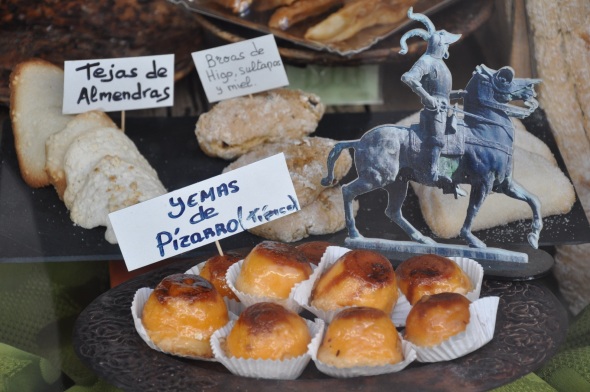
Bakery selection in Trujillo
Getting there from the UK
There aren’t any direct flights from the UK to Extremaduran towns so realistically, the choice is between Seville to the south of the region and Madrid to the north east. Ryanair fly to Seville from London’s Stansted airport, BA, Ryanair and easyJet from Gatwick. If you’re wondering why Iberia’s missing from the list, it codeshares with BA on their LGW flight. From regional airports, you’ll have to connect as there are no direct routes.

Ryanair en route to Seville
Those same airlines will also carry you to Madrid, plus Norwegian, a low-cost carrier operating out of Gatwick, as well as Iberia Express and Air Europa also from Gatwick.
Getting to and from the airport
I flew into Seville and out of Madrid on this trip but there’s no reason why you can’t do a round trip route or reverse the itinerary. To get into Seville from the airport I caught the airport bus, buying a ticket while I queued up for a few euros. It stops at the train station Santa Justa, skirts the old town and ends up at the main bus station, making it a convenient option wherever you’re staying.
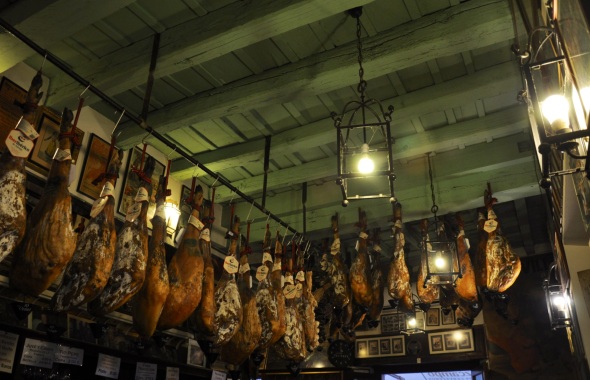
One of the most atmospheric bars in Barrio Santa Cruz, Seville
In Madrid, my train’s final destination was Chamartin station to the north of the city centre but I bailed at Atocha. Getting to the airport was straightforward; the cercanias or stopping trains are quickest but go to Terminal 4. I’d opted to fly Ryanair which left from Terminal 1 and so I connected to the airport using metro line 8.
Getting around
Whether or not you’ll need to rent a car depends on whether you wish to explore the region’s attractive countryside and villages or stick to the main towns. There are a few train connections, such as between Badajoz to the west and the Spanish capital, but for me, on many of the routes I wanted to use, buses operated to a more convenient schedule. Operators include LEDA, ALSA and Avanza.
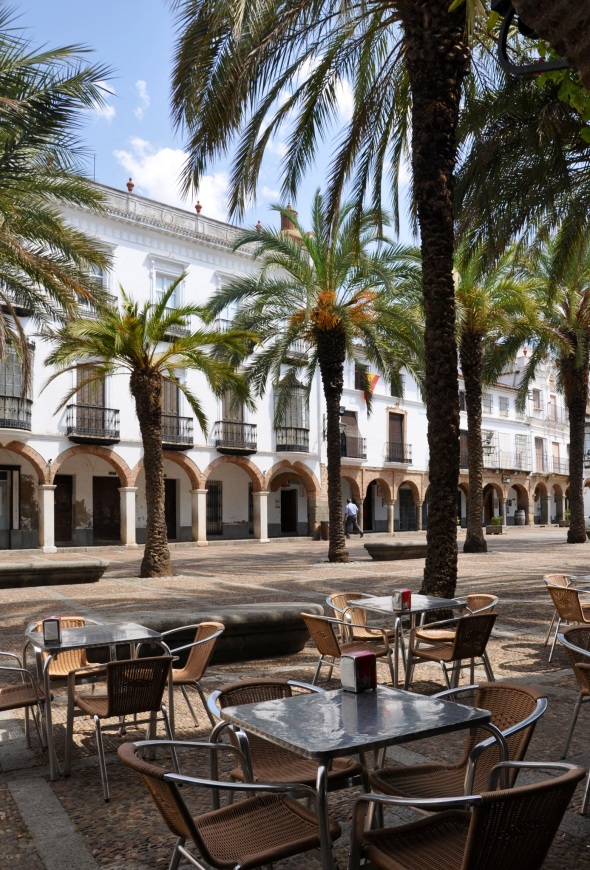
Every town has a main square; this is Zafra’s
I caught the bus from Seville to Zafra; you can buy a ticket to Mérida for around 10 euros. Although it’s possible to alight at Zafra, as far as I could work out, I couldn’t buy a ticket to Zafra online (you can in person) so I needed a separate ticket from Zafra to Mérida. Book online at http://www.alsa.es. It was just a few euros – well worth it for the chance to see this charming little town.

Pizarro’s mansion in Trujillo
From Mérida to Cáceres, an hour or so further north, I used LEDA; find them at http://www.leda.es where they also offer online booking. A single ticket costs just under 6 euros. From Cáceres, I made a sideways hop to atmospheric Trujillo for under 4 euros each way, leaving my bag in a locker at the bus station back at Cáceres. Tickets from the brand new and barely open bus station in Trujillo only go on sale fifteen minutes before the bus departs with Avanza but the buses weren’t full.
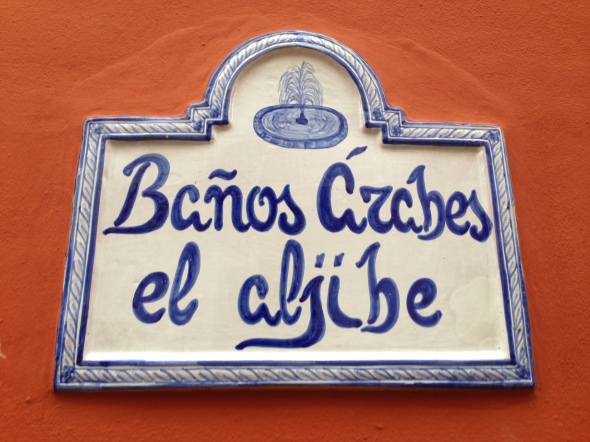
The hammam at Cáceres
To explore Monfragüe National Park and the La Vera valley in a day, there was no alternative to hiring a car. I used Europcar as its office was an easy walk from my Plaza Mayor base and also a straightforward and mercifully short drive to the ring road, easing the pain of town traffic. I did get a tiny bit lost getting the car back but I was only a few blocks out.

Birds take flight over the Ciudad Monumental
To get from Cáceres to the capital Madrid, I figured a train might be more reliable (it wasn’t – we were 40 minutes late getting in) and the train ticket on one of RENFE’s Media Distancia trains was also considerably more expensive than the buses I’d taken – around 32 euros.

The Extremaduran countryside as seen from the train
Where to go
Where to start? There are so many incredible destinations that it’s hard to whittle them down. In order, here are the places I visited during my Extremaduran holiday.
Zafra
This small town felt more like an Andalusian town than an Extremaduran one, though as it was the first stop on my itinerary, I hadn’t at that point worked out what an Extremaduran town might feel like. It has a pretty double square with lots of pavement cafes and tapas bars. I was there just for the day but I am told the food scene is good there – something for next time. The town also has a castle, now converted into a parador, and plenty whitewashed alleyways adorned with window boxes stuffed full of geraniums.
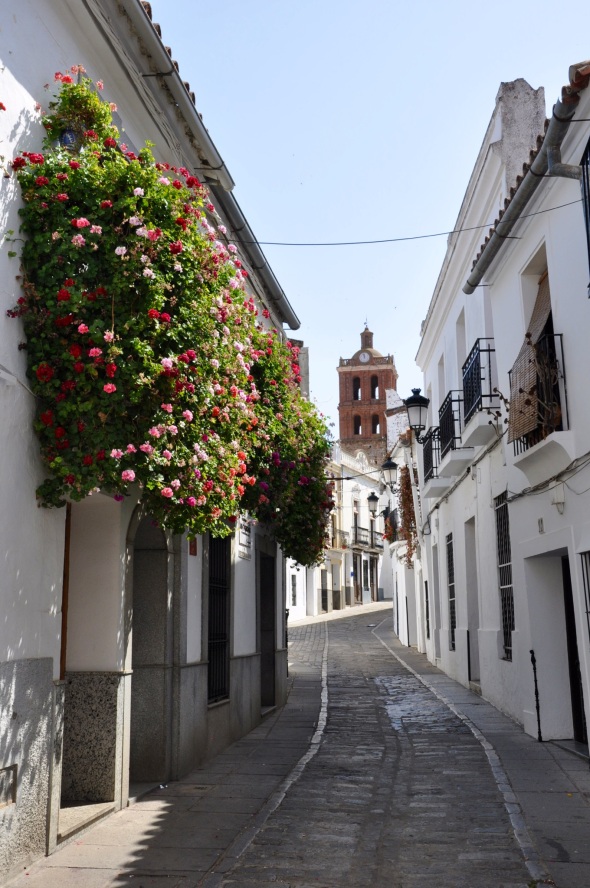
Street leading to the main squares
Mérida
This town is supposed to have the best preserved Roman remains in Spain. The sheer number of ruins was impressive, but some sights had more of the wow factor than others. There’s a partially reconstructed amphitheatre next to a fantastic open air theatre. Then there’s the breathtaking Temple of Diana which is literally plonked halfway along the main street with shops and cafes either side; OK technically it was there first but it does look so out of place it’s a bizarre sight. A restored Roman bridge, old fort with atmospheric cistern, Moorish remains and Forum are also easily accessible within the town centre.

Merida’s Roman theatre
Trujillo
This charming town was my favourite, home to conquistador Pizarro whose statue dominates the main square. Actually, that statue was supposed to be of Cortes, but the Mexicans didn’t want it so it was re-purposed as a Pizarro statue instead. The historic centre of Trujillo is packed full of mansions, including Pizarro’s, as well as myriad churches, towers to climb, a museum about the conquest of Peru and a hilltop castle.

View over Trujillo’s rooftops
Cáceres
The main attraction of this large town is its Ciudad Monumental, a walled old town which is also a UNESCO World Heritage Site. Just wandering amongst its alleyways late in the day was a delight; the addition of a very talented flamenco singer playing Spanish guitar was the icing on the cake. Outside the Ciudad Monumental, the Plaza Mayor was the centre of the action when it came to food and drink, though nearby San Juan had better food. The town also has a hammam with the usual hot, warm and cold baths – massage optional.

Flamenco singer in Cáceres’ Ciudad Monumental
Monfragüe National Park
This, I read, was Spain’s 14th national park but it was the one place I visited that made me gasp. At the Salta del Gitano lookout in the centre of the park, the River Tajo meanders between a couple of rocky outcrops. I visited in the morning and the water was a vivid green – a spectacle in itself but even for someone who can’t see the point of birdwatching, the sight of a black vulture close up was pretty impressive. The winding drive through the park was very pleasant and, if you don’t visit in the height of summer when the temperatures soar, the area is great for hiking.

Salta del Gitano
La Vera
This valley connects a series of pretty little villages, many of them worth a stop. Pasarón de la Vera was my first stop, its setting the main draw. From there, a short drive took me to Jaraíz de la Vera, known for its peppers, and then to Cuacos de Yuste, where the monastery housed the Spanish King Carlos V towards the end of his life. I drove on as far as Jarandilla de la Vera where there was an impressive Roman bridge and several natural swimming pools (a big thing in these parts) before backtracking to Garganta de Olla, a quaint little village with a plethora of half-timbered houses overhanging its narrow streets. Taking the mountain route via Piornal provided the adrenaline rush to end the day – though fortunately by that I mean returning to Cáceres and not going over the cliff edge.

Natural pool on the edge of Jarandilla de la Vera
The ones that got away…
This was my first trip to this region and there were quite a few places I didn’t have time to visit – this time! I’ll be back, one day, to visit Alcántara and its bridge as well as to Montánchez, Monesterio and to Casar de Cáceres for the food.
Watch out for more blogs covering Extremadura in the near future for more on these fantastic places.


Hello Julia,
great review as always. You have a natural talent for taking photographs that tell a story. Very informative for any would be traveler to the region.
Alex
LikeLiked by 1 person
July 13, 2016 at 8:19 pm
Thanks Alex!
LikeLike
July 13, 2016 at 8:27 pm
Pingback: Been there, done that, now what? | Julia's Travels
Trujillo was my favourite. What a fabulous region of Spain. Keep it a secret and don’t tell too many people about it!
LikeLike
October 7, 2016 at 2:00 pm
It might be a little late for that, Andrew – I’ve been signed up by my local travel club to give a talk. But you do have a point!
LikeLike
October 7, 2016 at 2:11 pm
Ha Ha! A wonderful region of Spain.
LikeLiked by 1 person
October 7, 2016 at 2:14 pm
I have my seventh trip to that beautiful region booked for next May. I am keen to spend some time in the North (the furthest I’ve been so far is Plasencia), but being based in Medellin (No hardship at all!), I have seen more of southern Extremadura – a couple not mentioned here that are worth a visit are Alburquerque, Olivenza & Jerez De Los Caballeros…oh and Feria! The place and it’s people are quite wonderful 🙂
LikeLike
December 6, 2016 at 10:19 am
Thanks for the tips, I’m sure I’ll be making a return visit too.
LikeLike
December 6, 2016 at 10:26 am
Pingback: Best kept secrets? I’ll give you a few of mine… | Julia's Travels
Pingback: Review of the year 2016 | Julia's Travels
Pingback: 14 Extremadura-related blog posts worth a read
Pingback: Five foods you must try on your travels | Julia's Travels
Lovely photos. You might be interested in this: https://planktonproduktions.wordpress.com/2017/01/01/blog-post-title/
LikeLike
December 11, 2017 at 8:07 pm
Beautiful pictures! My friend Paul Shoul, an amazing photographer, wrote a recent article about the cuisine of Extremadura. I think you’d like to read it and the pictures are amazing! Here is the link. https://www.mediterraneanliving.com/flavor-extremadura-spain/
LikeLike
March 9, 2018 at 8:36 pm
Hi Julia, I’ve been to Spain 11times but not to Extremadura. I’m a (young) 70 year old woman who travels solo and don’t want to drive. Can you suggest a couple of bases from which I could do day trips by bus? Is it very expensive to hire a driver for a national park tour? I’m a slow traveler and like to soak up atmosphere besides seeing the top sights. I have no idea of distances between towns. I can say 10 days to 2 weeks next September or October. Which do you recommend? Can you recommend a book?
Best regards,
Kathy Felgran
LikeLike
November 11, 2019 at 6:06 pm
Hi Kathy, if you’re hoping to day trips by bus then I’d say Caceres is the most convenient base, or Merida, Spain’s good value and so a car with driver for a day won’t break the bank. I think you should have a read of the Piggy Traveller website http://www.piggytraveller.com/. Irene’s a local but based in the UK and fluent in English. There’s nothing she doesn’t know about her home region!
LikeLike
November 11, 2019 at 6:20 pm